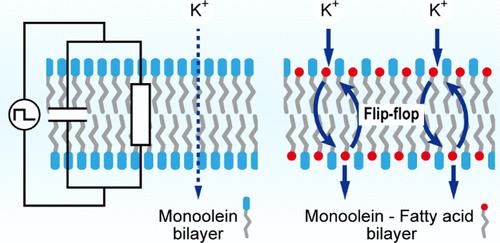单油酸-脂肪酸双分子层的电生理特性
IF 3.9
2区 化学
Q2 CHEMISTRY, MULTIDISCIPLINARY
引用次数: 0
摘要
原始细胞是区分自我与非我的原始隔间,了解它们的进化对于探索生命的起源至关重要。脂肪酸和单甘油酯被认为是原始细胞膜的关键成分,因为它们能够自组装成具有营养交换能力的双层和囊泡。在这项研究中,我们研究了单甘油酯和脂肪酸混合物组成的平面双分子层的电生理特性,采用液滴界面双分子层系统。研究了三种不同烃链长度的脂肪酸──油酸(C18)、棕榈油酸(C16)和肉豆醇酸(C14)──与单油酸(C18)结合,以评价链长和组成对双层稳定性、厚度和离子渗透性的影响。结果表明,纯单油双分子层比磷脂双分子层具有更强的离子渗透性,这是现代细胞膜的特征。此外,脂肪酸掺入单油双层破坏了膜结构的稳定性,进一步增加了离子的渗透性。我们认为这种增加的渗透率可能是由三个分子特性驱动的。首先,单油蛋白的楔形形状可能会破坏双层的堆积,并诱导瞬态孔隙的形成。其次,脂肪酸在双分子层小叶之间的快速转换可能促进了离子的运输。第三,单油酸与肉豆蔻烯酸之间的链长不匹配进一步破坏了双分子层的稳定性,促进了结构缺陷的形成。这些发现表明,单甘油三酯-脂肪酸双层结构中的组成基序可能提供了一种替代的离子运输机制,如在蛋白质转运体进化之前的早期原始细胞膜中两亲分子的翻转。本文章由计算机程序翻译,如有差异,请以英文原文为准。

Electrophysiological Characterization of Monoolein-Fatty Acid Bilayers
Understanding the evolution of protocells, primitive compartments that distinguish self from nonself, is crucial for exploring the origin of life. Fatty acids and monoglycerides have been proposed as key components of protocell membranes due to their ability to self-assemble into bilayers and vesicles capable of nutrient exchange. In this study, we investigate the electrophysiological properties of planar bilayers composed of monoglyceride and fatty acid mixtures, using a droplet interface bilayer system. Three fatty acids with varying hydrocarbon chain lengths─oleic acid (C18), palmitoleic acid (C16), and myristoleic acid (C14)─in combination with monoolein (C18) are examined to evaluate the influence of chain length and composition on bilayer stability, thickness, and ion permeability. The results show that pure monoolein bilayers exhibit enhanced ion permeability compared to phospholipid bilayers, which are characteristic of modern cellular membranes. Furthermore, the incorporation of fatty acids into monoolein bilayers destabilizes the membrane structure and further increases ion permeability. We consider that this increased permeability is likely driven by three molecular characteristics. First, the wedge-like shape of monoolein may disrupt bilayer packing and induce transient pore formation. Second, the rapid flip-flop of fatty acids between bilayer leaflets likely facilitates ion transport. Third, the chain-length mismatch between monoolein and myristoleic acid further destabilizes the bilayer, promoting the formation of structural defects. These findings suggest that compositional motifs in monoglyceride-fatty acid bilayers may provide an alternative ion transport mechanism, such as the flip-flop of amphiphilic molecules, in early protocell membranes before the evolution of protein-based transporters.
求助全文
通过发布文献求助,成功后即可免费获取论文全文。
去求助
来源期刊

Langmuir
化学-材料科学:综合
CiteScore
6.50
自引率
10.30%
发文量
1464
审稿时长
2.1 months
期刊介绍:
Langmuir is an interdisciplinary journal publishing articles in the following subject categories:
Colloids: surfactants and self-assembly, dispersions, emulsions, foams
Interfaces: adsorption, reactions, films, forces
Biological Interfaces: biocolloids, biomolecular and biomimetic materials
Materials: nano- and mesostructured materials, polymers, gels, liquid crystals
Electrochemistry: interfacial charge transfer, charge transport, electrocatalysis, electrokinetic phenomena, bioelectrochemistry
Devices and Applications: sensors, fluidics, patterning, catalysis, photonic crystals
However, when high-impact, original work is submitted that does not fit within the above categories, decisions to accept or decline such papers will be based on one criteria: What Would Irving Do?
Langmuir ranks #2 in citations out of 136 journals in the category of Physical Chemistry with 113,157 total citations. The journal received an Impact Factor of 4.384*.
This journal is also indexed in the categories of Materials Science (ranked #1) and Multidisciplinary Chemistry (ranked #5).
 求助内容:
求助内容: 应助结果提醒方式:
应助结果提醒方式:


